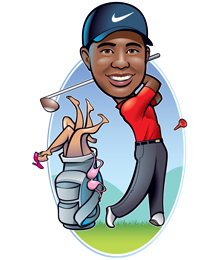The Media and Professional Sports
April 5, 2010 by Vito La Giorgia
Filed under lifestyle
 The media has successfully intertwined itself into the DNA of professional sports, an arena where previous athletes that stood tall above their sport were not as aggressively marketed as they are today. Find out how the business side of sports has broken the loyalty of the game, while influencing individuals to follow the legacy of its given leaders.
The media has successfully intertwined itself into the DNA of professional sports, an arena where previous athletes that stood tall above their sport were not as aggressively marketed as they are today. Find out how the business side of sports has broken the loyalty of the game, while influencing individuals to follow the legacy of its given leaders.
Tiger Woods
Golf is an experience that has been highlighted by many great players over the years. This refined game is the kind of experience that can take six hours out of your busy schedule without regrets. Tiger Woods has motivated new groups across the world to tap into this skilled pastime, and tune into televised golf like never before. Woods wasn’t simply good for golf, for a while he was golf. Without him, the sport will never be the same.
Unfortunately, his recent ‘mistakes’ and temporary departure from the game will make a smooth return to his power status trickier than the back nine at Pebble Beach. Since his absence, the Professional Golfers’ Association of America (PGA) has not been able to find its ratings in Woods’ golf bag. CBS news reported the numbers without him during his eight-month knee surgery and rehabilitation in 2008 were sometimes half of what they were when he was on the green and on our screen. Are we watching golf for golf, or are we watching golf for Tiger Woods? Apparently half of us are watching for the latter.
To make matters worse, there isn’t a sport out there that has more sex jokes linked to it than golf. Let’s just say that whenever the broadcaster casually concludes, “Tiger just can’t get his balls out of the rough today,” it will take a lot of naïve people not to chuckle. Jealousy is very much alive in the relationship that fans have with pro athletes. The questions are when, where, and who will mutter the word ‘cheater’ during Woods’ backswing. The only positive that will come from this water well of controversy is the ratings that pro golf will be able to pimp out of his ‘return to greatness.’ Woods will be teeing off in Augusta at the Masters Tournament in April. According to the top news and sports leaders, he is predicted to help draw the largest ratings in PGA history. That green blazer in Augusta suits him, but will golf throw him under the tour bus if he cracks at the Masters? Whatever happens, the media will be right there to catch every moment.
Sidney Crosby
The face, the future and the frenzy that Sidney Crosby creates inspires millions around the world to follow the great game of hockey. These elements help the capitalistic side of hockey build its capital. The hype machine uses Crosby’s poster-boy appeal to catch ‘bandwagoners’ looking for cheap thrills and retain customer equity from long-time lovers of the ‘coolest game on Earth.’ The funny thing about these newbie fans is that they’re getting sold on the sizzle and not the steak. So what if they don’t know what icing is; as long as hockey’s subliminal marketing message puts bums on seats, they’re happy. Sid ‘The Kid’ rides this new wave through the frontal lobe of these impressionable individuals and his boyish good looks get crystallized in their hippocampus. The marketing team’s goal is to get us to think about Crosby when we hear the word ‘hockey.’ This undoubtedly results in the many fans that wear his jersey in opposing arenas.
Americans have earned a bad reputation over the years for not knowing or caring about the ins and outs of Canada’s great game. The Kid was NHL Commissioner Gary Bettman’s best chance to educate our neighbours to the south. With Crosby in one hand and hockey in the other, he smashed them together and sprinkled the magic dust over the world with the Cheshire Cat grin on his face. Regardless of what country you’re in, when Crosby comes to town, expect scalpers to raise ticket prices dramatically. He is sold as the best, therefore, according to our crafted expectations; he must perform at full-capacity at all times. It’s turned into a situation where we want him to score 10 goals, as long as the final result is 11 – 10 for our side.
The fact is that certain athletes must be bigger than the game in order to keep the sport alive. Without them, who will be responsible for persuading non-diehard fans with the front-cover exposure needed to jump on board? Take Wayne Gretzky’s arrival in Los Angeles, for example, a deal known as ‘The Trade.’ Gretzky needed to be bigger than the game in order to sell hockey on the West Coast. With the media hype at his back and the California sun on his face, The Forum in Inglewood went from 7,000 fans to
full-capacity upon his arrival. Buzz-worthy players like Gretzky and Crosby carry the game on their talented shoulders under the brightest lights their sport has to offer. All this is in the effort for progression on many levels, ultimately ending in profitable gain.
Michael Schumacher
Formula One is the pinnacle of the international racing scene. According to the official F1 site, Michael Schumacher is “statistically the greatest driver the sport has ever seen.” After a brief retirement, Germany’s legendary driver has decided to return to the sport he owned for over a decade under a different coat. This time he decided to trace his German roots. He returned his Ferrari Enzo to the Italians and joined his countrymen on a new journey. “Schumi” is the new front man for team Mercedes GP. The car is the integral piece of the winning formula. Italian-made Ferrari is the masterpiece that Schumacher drove into the winner’s circle more often than anyone else in the history of the sport.
Many people are part of the team but there is only one man on the track. It will be interesting to see if the tifosi (Ferrari fanatics with uncompromised pride) will still cheer for their old champion. Out of all the athletes talked about in the world, he might be the one who dwarfs his sport the most. The question asks: Is Schumacher truly the greatest driver or is Ferrari the greatest racing car of our time? If a tifoso puts the Ferrari horse back in the barn and throws on a Mercedes-Benz cap, then we know for sure that the athlete is bigger than the sport.
The last time the Italians and the Germans joined forces with such enthusiasm, the end of the world was in sight. Thankfully, the reputation of McLaren’s stud, Lewis Hamilton, is the only thing to worry about. Would-be poster boy Hamilton lives in the top-tier of the F1’s talent hierarchy; only Schumacher can deliver the humbling performances that would cause the Brit to constantly look over his shoulder and make driving headlines that much more interesting.
Cheryl Bernard
Canadian Cheryl Bernard, the silver medalist at the 2010 Olympic Winter Games, would probably not like to be known simply as a curling cougar. Players in a sport that gets its fair share of playful ribbing need tough skin if they intend to stay focused and guide their rocks to victory. Curling can continue to exist in its given realm or it can find new ways to get people to curl in order for the sport’s popularity to grow. Alternatively, it could do what many other sports have done, which is become scantily clad in front of the camera. The formula that professional sports has adopted, known as “sex sells,” often works by exposing the athletes in order to achieve exposure for their sport and bring in the riches.
Before 2005, when Bernard, and fellow curling females decided to pose nude for a calendar, curling was a wholesome sport that chose not to pimp out their players by offering them to the media. The Courtney Cox look-a-like also co-wrote Between the Sheets: Creating Curling Champions.
Greed might be the cornerstone upon which the empire of sport is built. As Michael Douglas said in Wall Street, “greed is good.” Players (who in some cases have grown up modestly and who now own million-dollar mansions) would probably agree, as long as the cheques keep coming in. Unfortunately, what these players did not foresee was the responsibility that comes with such status. As we’ve seen in the past, turning athletes into role models is the intangible part of the deal that often gets broken. In so doing, they ruin the lives of players who let the bright lights we place over them burn their toned physiques to the core, leaving them and their fans asking ‘Why?’ This is not the case for all athletes, but all humans fight and all humans suffer; as Frederick Douglass said, “If there is no struggle, there is no progress.” We hope that athletes who are sold to the media as being bigger than the game will learn from their past heroes’ mistakes, and be able to balance their life as best as possible, both in and out of the spotlight. When it comes down to it, we love our sports, and the game is one of the most legitimate businesses in a very corporate and corrupt world. If this means showing us the bodies that athletes have worked so hard at fine tuning in order to sell their sport, so be it. Keep them on the grand stage, keep them honest, and keep us entertained.
What I want to know is what turns you on: attractiveness or athleticism?










Comments
Feel free to leave a comment...
and oh, if you want a pic to show with your comment, go get a gravatar!